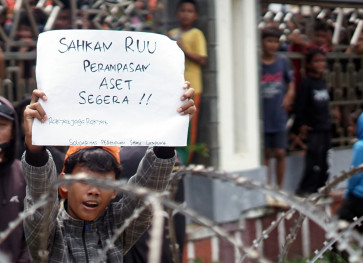Popular Reads
Top Results
Can't find what you're looking for?
View all search resultsPopular Reads
Top Results
Can't find what you're looking for?
View all search resultsDocumenta 15: Exposed anti-Semitism or misjudged anticommunism critique?
As the ruler of the largest and most populous country in Southeast Asia, Soeharto was the pronounced darling of the "Western community of values".
Change text size
Gift Premium Articles
to Anyone
O
n June 24, the Indonesian artist-group Taring Padi, whose incriminated giant banner titled "People's Justice" was retracted, rolled up and removed, released a statement saying, among other things:
"As a collective of artists who condemn racism of any kind, we are shocked and saddened by the media coverage that labels us as anti-Semitic. We would like to emphasize our respect for all people, regardless of their ethnicity, race, religion, gender or sexuality. For a better understanding of our imagery, we would like to elaborate on the contextual reference to Indonesian history and the origin of our artwork.
“The eight-by-twelve-meter People's Justice banner was created collaboratively by numerous members of our collective in 2002 in Yogyakarta, Indonesia. The image was created against the backdrop of the difficult living conditions we had experienced under a military dictatorship in which violence, exploitation and censorship were commonplace. Like many of our artworks, the banner seeks to expose the complex power relations behind these injustices. In particular, it addresses the mass murder of more than 500,000 people in Indonesia in 1965, which has not been addressed to this day."
A real storm of protest was triggered in particular by two figures depicted on the banner -- one bears the inscription "Mossad" in the form of a pig's face on a hard hat, and the other is presented with a suit, serrated ragged teeth, a cigar in the corner of his mouth and SS runes on a black hat brim. In front of the latter is placed an oversized, fearsome mythical creature, which in the sense of the artist group possibly symbolizes the architect of the mass killing in the mid-1960s -- namely Soeharto.
As the ruler of the largest and most populous country in Southeast Asia, Soeharto was the pronounced darling of the "Western community of values". Since his predecessor and state founder, Sukarno, was suspected by this same "community of values" of leaning too strongly toward the People's Republic of China, he was considered an uncertain cantonist.
Especially in the Cold War era, the concentrated "West" -- led by the United States, the United Kingdom, Australia, the Federal Republic of Germany and Israel -- stood by Soeharto's side politically, economically and militarily. This was especially true of the intelligence support provided by these countries. Which corresponds, from the view of Taring Padi and in their coarse dressing, to a "pig system", where the appropriate "pigs" are represented, unvarnished, as such.
As for the Mossad, it managed Israel's relations with Indonesia after Soeharto came to power. Knowledge of the massacres and those behind them did not prevent the intelligence service from establishing economic and security ties with the military regime in Jakarta under a secret initiative called "House and Garden". Indonesia was given a code name for security reasons; occasionally the name "South Korea" was used.
According to research by Israeli human-rights lawyer Eitay Mack, Mossad established contacts with the Indonesian military regime to initiate joint-trade projects and organize bilateral exchanges and visits of officials and military personnel, which admittedly took place under the strictest secrecy.
The document prepared by the Mossad on April 6, 1967, in advance of the visit of an Indonesian delegation, stated: "We know little about their character, their way of thinking, or their actual relations with us. Nevertheless, we should not treat them as Africans, but rather as if they were Europeans."
Mack demands then today: "The Israeli Foreign Ministry and Mossad have a moral obligation to disclose all their documents on Indonesia from those years to help uncover the truth, just as Israel expects other countries to disclose the documents in their possession on the Holocaust."
Referring to the incriminated banner of Taring Padi, Israeli architect and architecture critic Eyal Weizman states: "The presence of this image at Documenta 15 illustrates a kind of 'boomerang effect', in which a paradigm developed in Europe circulates in a European colony and then returns -- in altered form -- to Europe. The boomerang metaphor also brings to mind work by Hannah Arendt and Aimé Césaire, who sought to describe how Nazi violence itself represented a return of racist worldviews and forms of violence that Europeans had developed in the colonies or had previously exported there."
And it was Rudolf Oebsger-Röder, of all people, an ardent ex-Nazi and SS-Obersturmbannführer, who was responsible for cultivating Soeharto's image at home and abroad as an ever "smiling general". After the war, Röder worked full-time for the Gehlen organization, the forerunner of the German Federal Intelligence Service (BND), among others. Later, he worked in Jakarta under the name O. G. Roeder both as a BND employee and as a correspondent for the Süddeutsche Zeitung and the Neue Zürcher Zeitung. In the Indonesian metropolis, he succeeded in gaining access to Soeharto and acting as his advisor and biographer, so to speak as the idealistic overall Nazi on the archipelago.
Roeder's boss, the former National Socialist and first president of the BND until 1968, Reinhard Gehlen, had praised Soeharto's rise to power in a report broadcast in mid-October 1996 by the ARD television magazine Monitor with the words: "The success of the Indonesian army, which [...] pursued the elimination of the entire communist party with consistency and severity, cannot, in my conviction, be overestimated in its significance."
Could it be that in Kassel a deliberately one-dimensional image "interpretation" -- on whose initiative and with what benefit?! -- was pursued? If in Germany "anti-Semitic pictures" of Indonesian artists arouse a storm of indignation, the German support of the so-called "New Order" under Soeharto and his unleashed anti-communist bloodlust should at least no longer be concealed.
In this respect, and even more so with a view to current developments in society, politics and art on both sides of Kassel, there is plenty to talk about, discuss and argue about rationally. If that is at all still wanted.
***
The writer is a political scientist and journalist with a focus on Southeast and East Asia. The original article in German has appeared on NachDenkSeiten (NDS) portal.











